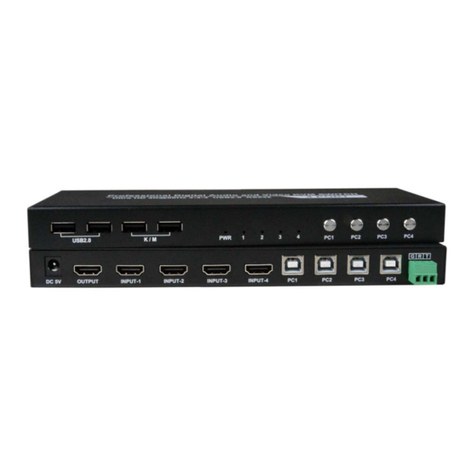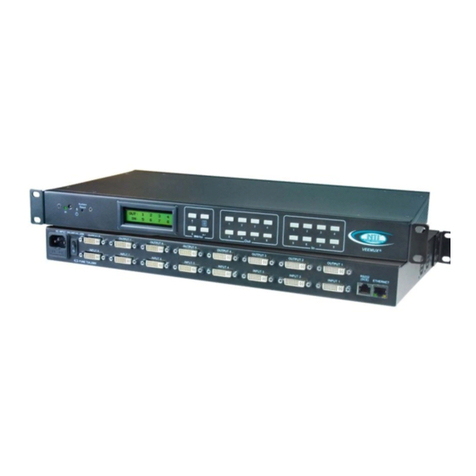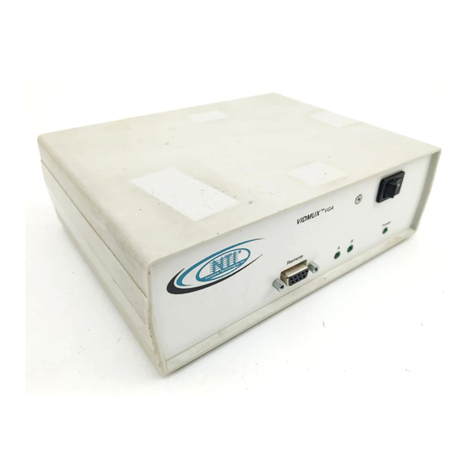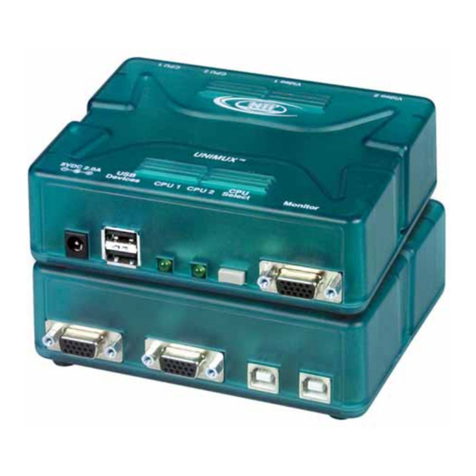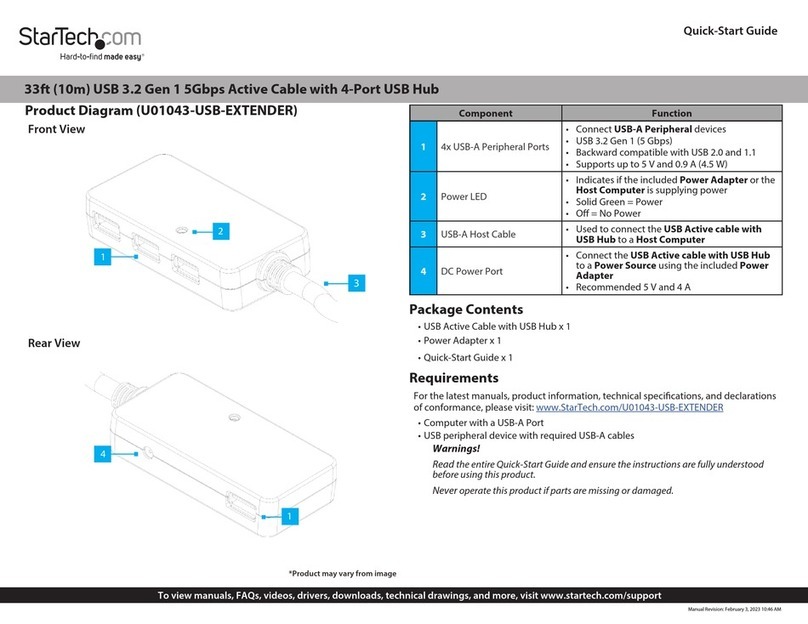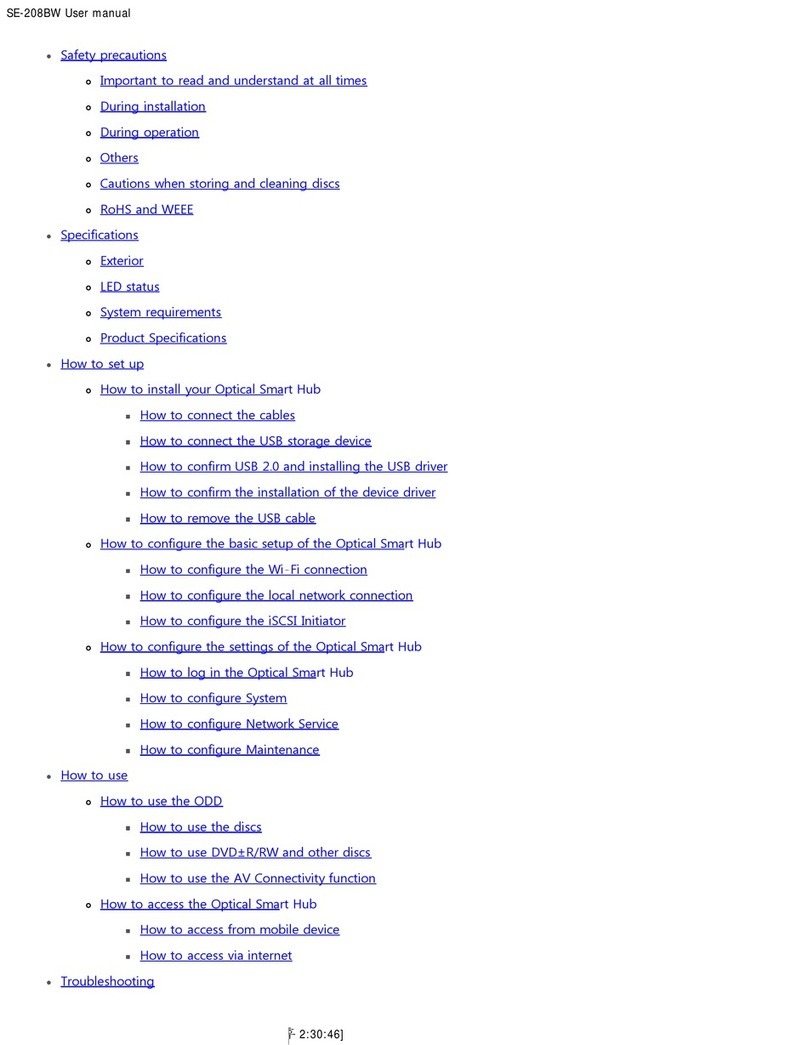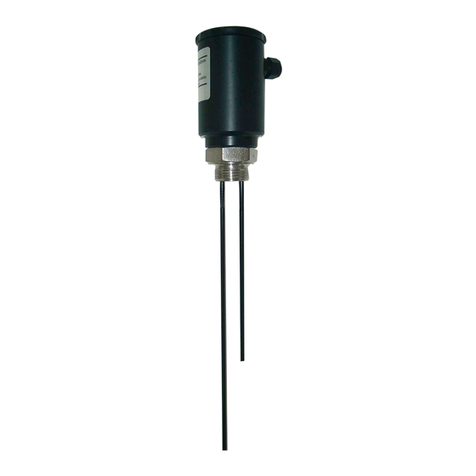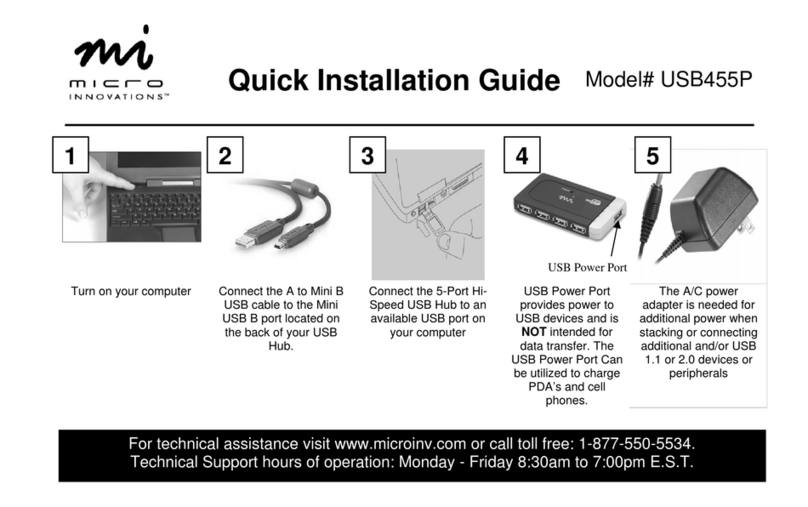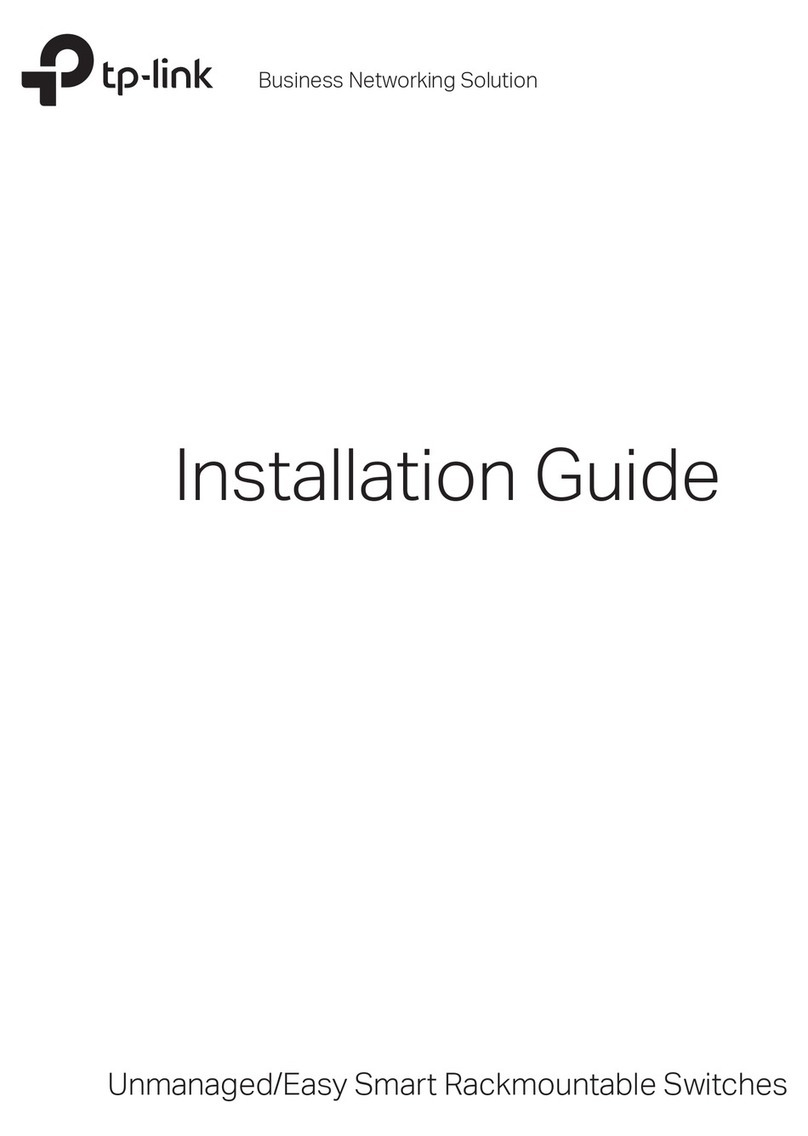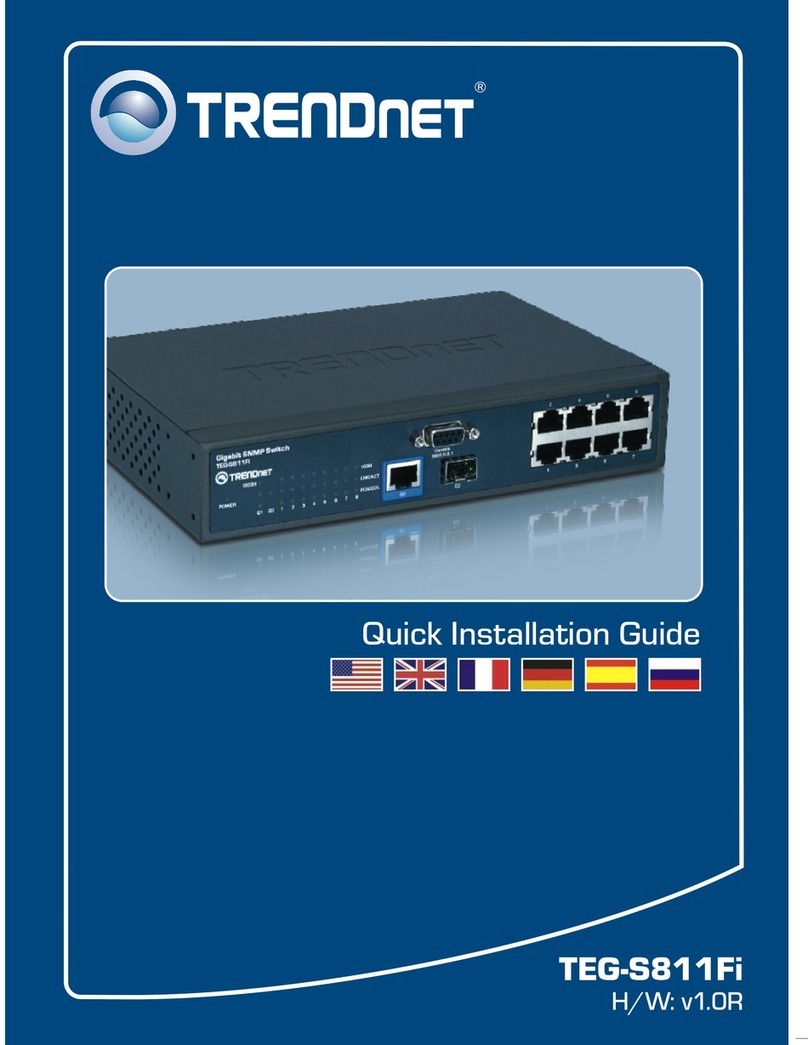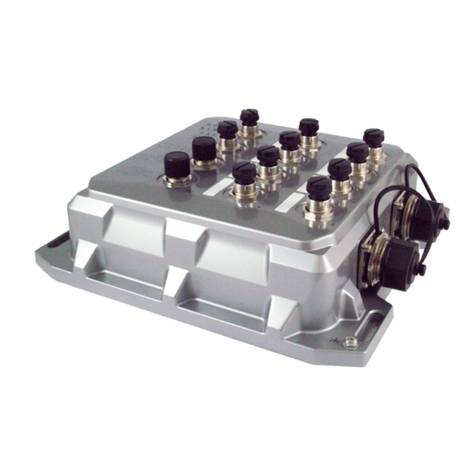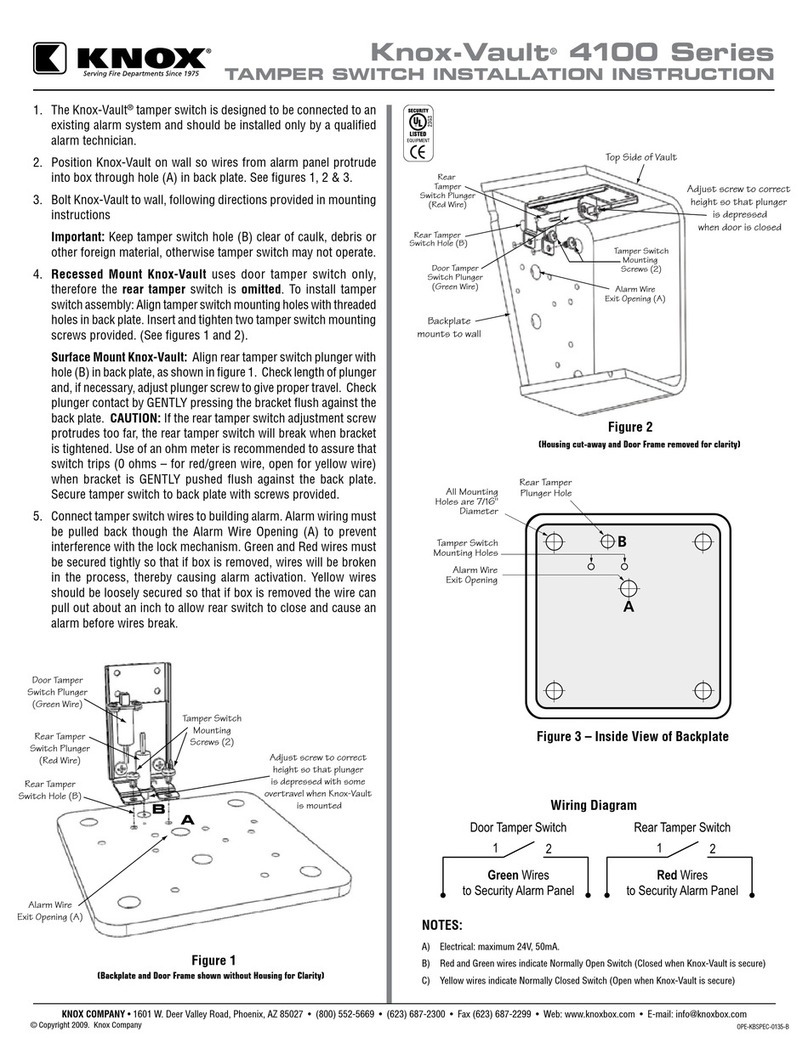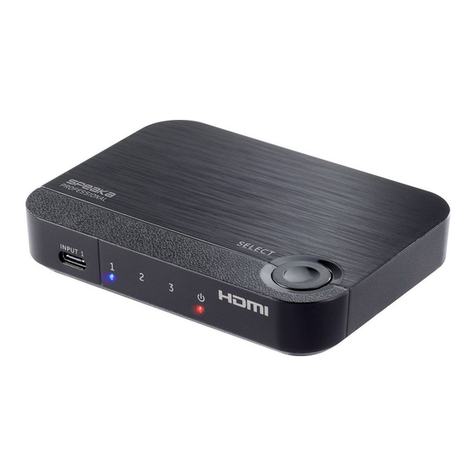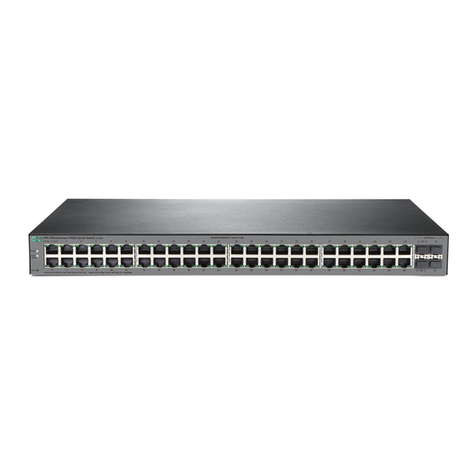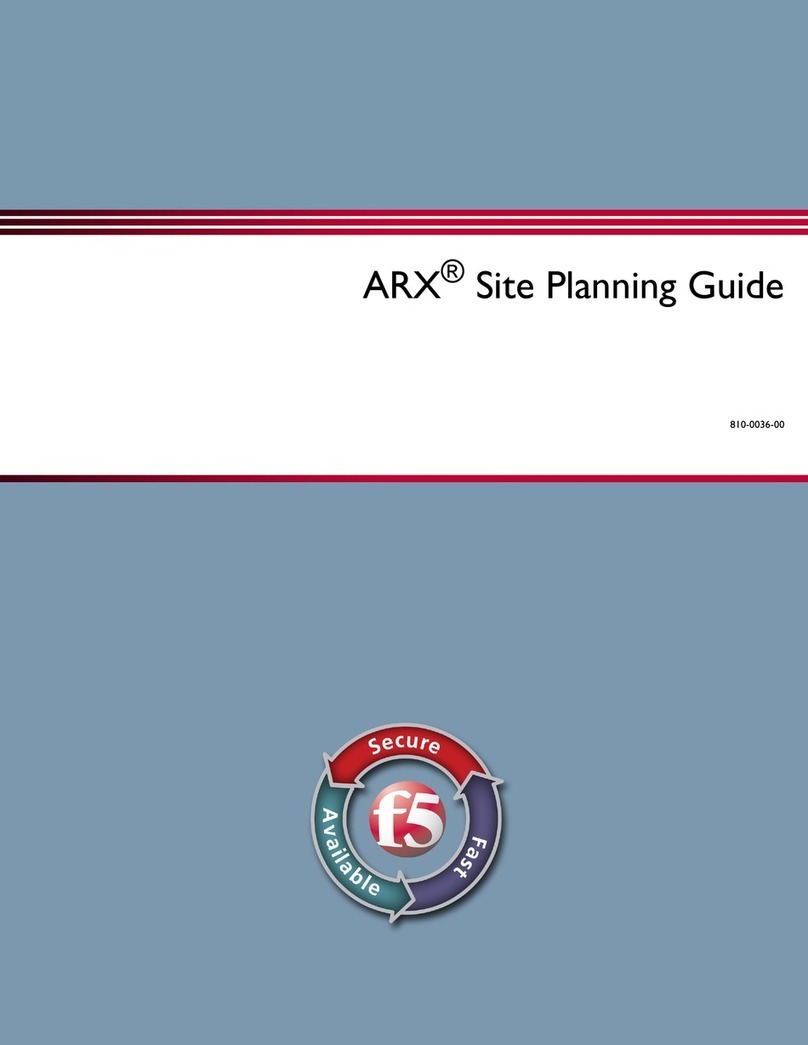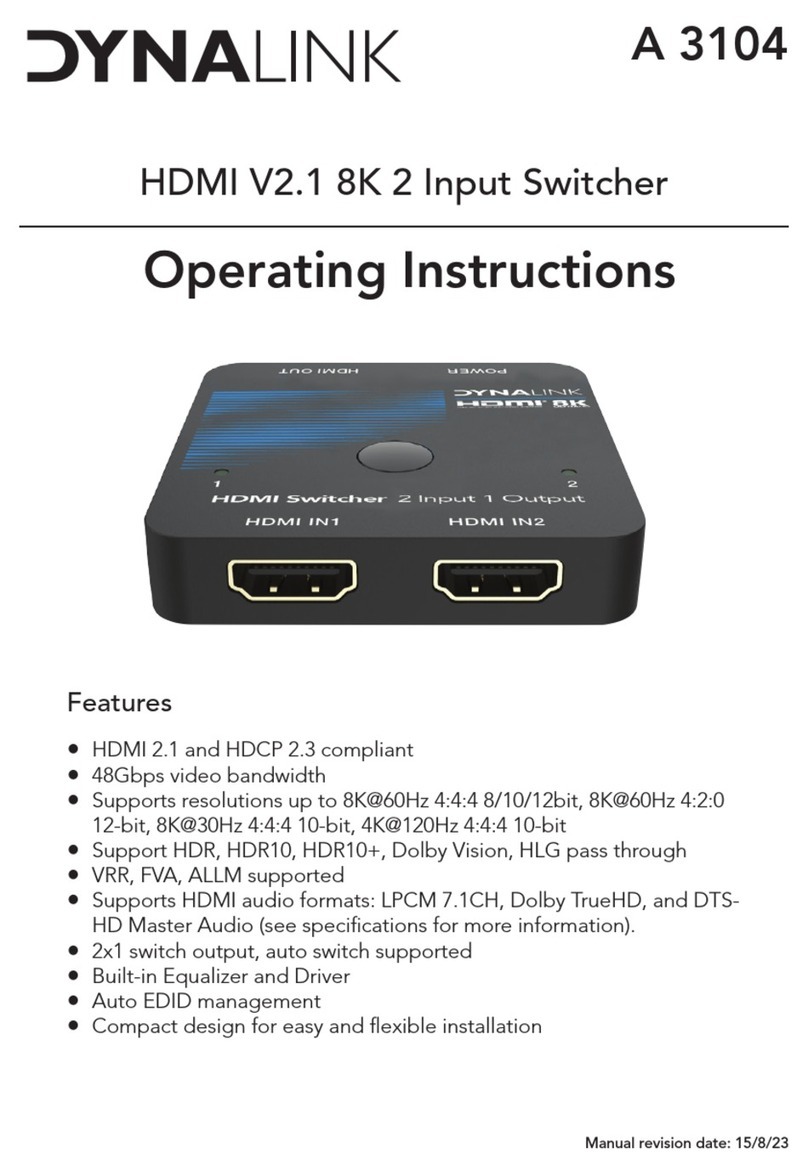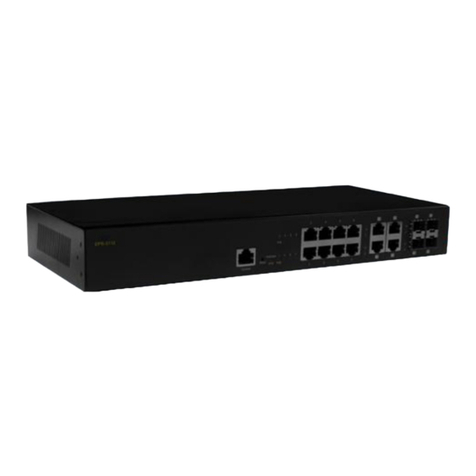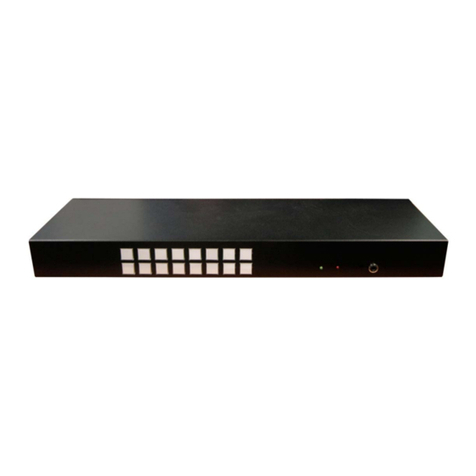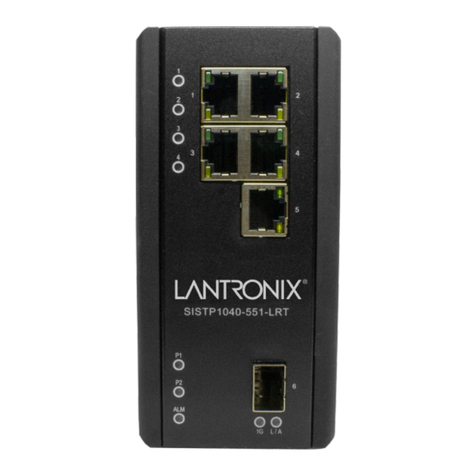NTI KEEMUX-Sx-O User manual

1
KEEMUX-Sx (SUN KVM Switch)
INSTALLATION / USER GUIDE
MAN061 Rev Date 3/30/2001
TABLE OF CONTENTS
Introduction......................................................................................... 2
Cables
Cables NOT supplied but required................................................... 2
Installation........................................................................................... 2
Keyboard Configuration..................................................................... 3
Cascading
Introduction....................................................................................... 3
Limitations.........................................................................................4
Configuration.....................................................................................4
Cascaded Installation........................................................................4
Using the NTI Switch
Front Panel Control...........................................................................5
Keyboard Control.............................................................................. 5
SCAN MODE........................................................................................ 5
BROADCAST MODE........................................................................... 5
Keyboard Updating……………………………………………………….. 5
How To Disable Operating Modes……………………………………… 6
Technical Specifications....................................................................10
Troubleshooting..................................................................................10
Warranty Information..........................................................................10
17, NETWORK
TECHNOLOGIES
INCORPORATED Tel:330-562-7070
Fax:330-562-1999
1275 Danner Dr
Aurora, OH 44202
SUN WORKSTATION SUN WORKSTATION
ON
OFF
NETWORK
TECHNOLOGIES
INCORPORATED
1 2 3 4 56 7 8
KEEMUX-Sx
17,
12345678
MODE
SCAN BROAD
CAST COM
MAND
SUN WORKSTATION
SUN WORKSTATION
SUN WORKSTATION SUN WORKSTATION
SUN WORKSTATION
SUN WORKSTATION

2
INTRODUCTION
The NTI Sun Switch allows a single keyboard, monitor, and mouse to communicate directly with any Sun workstation connected to
the switch (up to 32 computers with a single switch, depending on the switch model, or 128 computers when cascaded – see
CASCADE section). These computers can be file servers, network managers, etc. The auto-boot circuitry in the NTI Switch
allows all computers to boot simultaneously without keyboard error.
Available Options
1. Switch models are available in 60 or 50 Hz, and 110 or 220V.
2. A hard-wired remote control (RMT) is available. This remote comes
standard with a 25 foot cable (REXT-
xx
), but a cable of up to 250 feet can be ordered.
CABLES
Monitor, keyboard and mouse interface CABLES ARE REQUIRED but not supplied. Before beginning installation, refer to
installation drawing to insure that you have the proper type and number of cables needed.
1. SUCEXT-xx Connects the video port of the computer to the switch (up to 250 feet)
2. SUKINT-xx-MM OR SUKEXT-xx-MM Connects the keyboard port of the computer to the switch
Optional Materials:
1. SUCEXT-xx-MF Extension cable for the monitor. Use if the video cable is permanently attached to the monitor.
2. SUKINT-xx or SUKEXT-xx Extension cable for the keyboard.
3. REXT-xx-SR Extension cable for the optional wired remote and / or cascading units together.
Where:
xx = length of the cable
MM = male-male connector Cables can be purchase from Network Technologies Inc.
MF = male-female connector
INSTALLATION
1. Turn OFF power to all computers that will be connected to the NTI Switch before connecting or disconnecting any cables.
WARNING! YOU MAY DAMAGE YOUR COMPUTER IF YOU DO NOT TURN THE POWER OFF BEFORE CONNECTING OR DISCONNECTING CABLES.
2. If you are cascading units together, configure dip-switches accordingly (see Tables 2-4 on page 4).
3. Connect the monitor to the port labeled MONITOR on the rear of the NTI Switch.
4. Connect the keyboard to the port labeled KEYBD on the rear of the NTI Switch. (The mouse connects to the keyboard.)
5. For each computer:
Connect a cable from the Keyboard port of the computer to a Keyboard port of the NTI switch. Note the port’s number.
Connect a cable from the Video port of the computer to the Video port of the NTI switch with the same port number as the
keyboard. See the illustration below. Make sure the computer is connected to a Keyboard port and a Video port with the
same number. Otherwise, you may be typing commands to one computer, but viewing a different computer on the monitor.
6. Plug the NTI Switch into an AC power outlet.
7. If you will NOT be installing an optional wired remote control (RMT), go to Step 9.
8. Connect the RMT to the NTI Switch RMT IN port using the supplied REXT-
xx
cable.
9. Turn ON power to the NTI Switch, port 1 should illuminate. If it doesn’t, see TROUBLESHOOTING. The NTI Switch supplies
power to the optional RMT.
10. Turn ON power to any or all computers connected to the NTI Switch.
SUKINT-xx-MM
SUCEXT-xx
SUN WORKSTATION SUN WORKSTATION
SUN WORKSTATION
SUN WORKSTATION

3
KEYBOARD CONFIGURATION
The dip-switches on the front panel are configurable for several tasks. Switches 1-6 are used for cascading actions (see
CASCADING section) and switches 7 & 8 are for keyboard configuration. These keyboard configuration switches come pre-
configured with switch 7 in the “ON” position and switch 8 in the “OFF” position. You should not change these settings as thiswill
cause your SUN keyboard to not work. Should the positions of switch 7 or 8 get changed, you will need to power down the entire
system (including CPU’s), change the dip-switches back to the required position and then power the system back up. Should you
find the need to replace one SUN keyboard with another one, it can be hot swapped without powering down. Refer to Table 1 and
the following diagram for instructions on proper keyboard dip-switch configuration.
Keyboard dip-switch configuration
Table 1 (*default settings)
Keyboard / Mouse type SW7 SW8
SUN* ON OFF
CASCADING
The SUN switch can be expanded to access up to 128 CPU’s by cascading multiple units together. Up to 8 SUN switches can be
connected into another switches CPU ports, as illustrated below. The SUN switch connected to the monitor & keyboard must be
configured as the “MASTER” unit (via dip-switches). Any switches connected to the “MASTER” must be configured as “SLAVE”
units. All SUN switches are fully configurable for this expansion method, the only additional hardware required is a set of
keyboard, monitor & RMT extension cables for each “SLAVE UNIT” (see materials).
ON
OFF
17,
NETWORK
TECHNOLOGIES
INCORPORATED
12345678
Switch 7 - ON
Switch 8 - OFF
SE-8M13W3-8-A
KEEMUX-S8
(
slave unit 1
)
(
slave unit 2
)
(
slave unit 3
)
(
master unit
)
SUN
SUN
SUN SUN SUN SUN SUN SUN
REXT-SR-xx
REXT-SR-xx
REXT-SR-xx
SUCEXT-xx SUCEXT-xx SUCEXT-xx
SUKINT-xx-MM SUKINT-xx-MM SUKINT-xx-MM
SUCEXT-xx
SUKINT-xx-MM SUCEXT-xx
SUKINT-xx-MM SUCEXT-xx
SUKINT-xx-MM
SUCEXT-xx
SUKINT-xx-MM
SUCEXT-xx
SUKINT-xx-MM
KEEMUX-S8 KEEMUX-S8
KEEMUX-S8

4
1. LIMITATIONS
a. All the slave units must be the same size (4, 8 or 16 port)
b. Up to 8 slave units may be connected to form a maximum system size of 128 ports (1x8 port master + 8x16 port slaves).
c. Slave units must be added to the master unit in order (slave #1 to master’s port 1, slave #2 to master’s port 2, etc).
NOTE: Master Unit Port 1 (with an 8-port Slave Unit connected to it) will become ports 1-8 (1-4 for a 4-port slave, 1-16 for a 16-
port, etc.). Master Unit Port 2 (with a second 8-port Slave Unit connected) will become port numbers 9-16 (5-8 for a 4-port slave,
17-32 for a 16-port slave, etc.).
d. All units must be powered OFF during configuration and interconnecting.
e. For a Master Greater than 8 ports, only the first 8 ports may be configured for the Master/Slave option. The remaining ports
on the master are numbered from the last port of the last slave. Note: In a 1x32 Master w/8 1x8 slaves (8 slaves being the
maximum number allowed),ports 9-32 on the Master would become ports 65-88.
2. CONFIGURATION:
All units are configured using the 8-position switch (located on the front of each unit) according to the tables below (2-4):
Table 2 * (default settings) Table 3
Switch Master Slave Slave Unit Size SW5 SW6
SW1 OFF* ON Not Cascaded OFF OFF
SW7 ON* ON 4 Port OFF ON
SW8 OFF* OFF 8 Port ON OFF
SW5 SEE TBL 3 OFF* 16 Port ON ON
SW6 SEE TBL 3 OFF*
Table 4 * (default settings)
SW2 SW3 SW4 MASTER SLAVE
OFF* OFF* OFF* 1 slave attached Unit #1
OFF OFF ON 2 slaves attached Unit #2
OFF ON OFF 3 slaves attached Unit #3
OFF ON ON 4 slaves attached Unit #4
ON OFF OFF 5 slaves attached Unit #5
ON OFF ON 6 slaves attached Unit #6
ON ON OFF 7 slaves attached Unit #7
ON ON ON 8 slaves attached Unit #8
3. CASCADED INSTALLATION
a. Configure each switch as per above tables before proceeding.
b. Perform steps 1 & 2 under INSTALLATION for each slave unit.
c. With a SUCEXT-xx cable, connect slave #1 monitor port to master’s CPU-VID 1 port.
d. With a SUKINT/SUKEXT-xx-MM cable, connect slave #1 keybd port to master’s key 1 port.
e. Repeat steps c. & d. for each additional slave unit, keep in mind that each slave will connect into the next
available master’s port (i.e. slave #2 to master’s vid-2 CPU & key-2, etc.)
f. With a RMT extension cable, connect master’s RMT out port to slave #1’s RMT in port.
g. With another RMT extension cable, connect slave #1 RMT out port to slave #2’s RMT in port.
h. Repeat step g. until all slave units are connected together.
i. Repeat the installation section of the manual for any CPU’s to be connected to the master.
NOTE: If you are using an optional wired remote, it will be connected to the master switches RMT IN port.
KEY-3 KEY-2 KEY-1 KEYBD
KEY-4
CPU-VID-3 CPU-VID-2 CPU-VID-1
MONITOR
CPU-VID-4
MASTER UNIT (KEEMUX-S4)
SLAVE UNIT #1 (KEEMUX-S4) SLAVE UNIT #2 (KEEMUX-S4)
Fi
g
1
KEY-3 KEY-2 KEY-1 KEYBD
KEY-4
CPU-VID-3 CPU-VID-2 CPU-VID-1
MONITOR
CPU-VID-4
KEY-3 KEY-2 KEY-1 KEYBD
KEY-4
CPU-VID-3 CPU-VID-2 CPU-VID-1
MONITOR
CPU-VID-4

5
USING THE NTI SWITCH
The switch can be operated by the front control panel or by keyboard control.
Front Panel Control
1. Pressing any touch switch on the front panel will connect the selected computer to the keyboard, monitor, and mouse.
2. Holding down any front panel touch switch for more than 2 seconds will cause the switch to cycle through 3 extended modes
of operation: SCAN, BROADCAST and COMMAND (described in the
Keyboard Control
section below). 3 LED’s on the front
panel indicate when these modes are enabled. Release the touch switch when the LED’s show that the mode you desire is
On.
Keyboard Control
In order to control the switch with your keyboard, COMMAND Mode must be enabled. To enable or disable COMMAND Mode
from the keyboard:
•Press “CTRL” and “`” (accent key) at the same time.
All 4 status lights on the keyboard will light to indicate that command mode is enabled.
When the COMMAND LED is on, the following functions are available:
Table 4 (Command Functions)
→Increment port
←Decrement port
SEnable/disable Scan Mode
BEnable/disable Broadcast Mode
Txxx Sets scan time out period on each port. xxx = number of seconds which can be set from 002 to 255 (for example: t002
would set time out to 2 seconds).
Pxx Selects a specific port. xx = port number as a two-digit number (ex. p01, p08, p15, etc.)
NOTE: YOU MUST EXIT COMMAND MODE TO TYPE TO A COMPUTER. TO EXIT COMMAND MODE EITHER HOLD DOWN ANY TOUCH SWITCH ON THE
FRONT PANEL FOR MORE THAN 2 SECONDS OR PRESS <ESC>, OR PRESS <CTRL> + `(ACCENT )KEYS SIMULTANEOUSLY.
SCAN
When the SCAN LED is on, the switch scans through all powered ON CPU ports. By default, each port is active for 5 seconds
before switching to the next port. This time out period can be changed in COMMAND Mode described in Table 1.
NOTE: IF YOU TYPE OR MOVE THE MOUSE WHILE A PORT IS ACTIVE, THAT PORT WILL REMAIN SELECTED UNTIL THE KEYBOARD AND MOUSE
HAVE BEEN IDLE FOR A FULL TIME-OUT PERIOD.
BROADCAST(use with extreme caution)
BROADCAST Mode allows the operator to send keystrokes to all active computers simultaneously. However, BROADCAST Mode
has some critical requirements:
1. BROADCAST LED must be OFF when booting any attached computers.
2. BROADCAST LED must be ON and COMMAND LED must be off for keystrokes to reach attached computers.
KEYBOARD UPDATING
Keyboard configuration of each computer is saved in the NTI Switch. For example, if the computer attached to Port 4 had CAPS
LOCK and NUM LOCK selected the last time that computer was accessed, then they will automatically be set when that computer
is accessed again.

6
HOW TO DISABLE OPERATING MODES
The three operating modes of the KEEMUX-Sx SUN KVM switch can be disabled if a user desires to do so. The Command
Mode can be disabled which would also disable the Scan and Broadcast Modes, or, the Scan and/or Broadcast Modes can be
individually disabled leaving the other features in Command Mode enabled.
To disable these operating modes, the user must get access to the jumpers block. This block is located close to the dip
switches on the circuit board the keyboards plug into (called the digital board) inside the KEEMUX-Sx.
If the unit is a rackmount style, the digital board is located directly beneath the cover of the unit, requiring the user to only remove
the 9 screws from the cover to gain access. With the cover removed, the jumpers block will be easy to locate. Follow the
instructions under "CONFIGURING THE JUMPER BLOCK" on page 9 to disable the desired mode(s).
If the unit is in a plastic case, the digital board is located on the bottom of the case, requiring the user to partially disassemble the
unit to gain access to the jumpers block. If the unit has the OSD option (KEEMUX-Sx -O), the procedure will be different than
the procedure used if the unit does not have the OSD option.
For models KEEMUX-Sx (no OSD):
1. Make sure the KEEMUX-Sx is completely disconnected from all computer components. Be sure to
unplug the KEEMUX-Sx from the electrical outlet.
2. Remove the two philips-head screws from the underside of the KEEMUX-Sx and set the KEEMUX-Sx on
a firm and flat surface, bottom down.
3. Remove the top half of the plastic case from the KEEMUX-Sx.
Philips-head screws
holding the plastic case
together
View of bottom of plastic case
Video Board
Di
g
ital Board
Overhead view of video board on top of digital board.
The
j
umper block is located
below the LED board.
Rear Panel
Front Panel
L
C
D
E
K
C
M
D
B
R
D
C
S
C
A
N
JUMPER BLOCK DIP SWITCHES
LED board
Closeup view of jumper block on digital board.

7
NOTE: Before proceeding, it is important to discharge any static charge you may be carrying by touching any large metal object
(away from the KEEMUX-Sx).
4. The first visible circuit board, the uppermost board, is the video board
5 Along the back of the video board are between 3 and 5 video ribbons (depending on how many monitors
the unit is designed to connect to) connecting the video board to a circuit board on the rear panel with
15HD connectors on it. Disconnect the flat ribbon cables from the video board to each header on the
rear panel. Take note as to where they go for re-assembly later. Do not disconnect them from the video
board headers.
6. There are 4 nuts that secure the video board to standoffs. Remove the 4 nuts.
To avoid further more difficult disassembly, the video board and front panel will be removed from the KEEMUX-Sx as an
assembly.
7. Carefully loosen the video board from the standoffs. With it loosened, grasp firmly the video board and
front panel at the same time and slide the front panel up out of the slots in the plastic case that support it.
Once clear of the case, pivot the assembly back approximately 1", just enough to expose the jumper
block. Be careful not to dislodge the connection of the ribbon connecting the front panel to the digital
board. If it appearsto become loose, be sure to reseat the connection before re-assembly. Now follow
the instructions under "CONFIGURING THE JUMPER BLOCK" on page 9.
Lift and pivot board and front
panel......
....and set back enough
to clear jumper block.
Set video board and front panel assembly back far enough to clear jumper block.
Jumper block
Standoffs
Be careful not to scratch the bottom
of the circuit board on standoff
threads.
Ribbon from LED
board to digital board
Disconnect video
ribbons here
Nuts (4) secure the circuit board
to the standoffs.
Video Board
Digital Board
15HD Connector
Overhead view of video board on top of digital board.
The jumper block is located
below the LED board.
LED Board
Front Panel
Rear Panel

8
For models KEEMUX-Sx-O (with OSD):
1. Make sure the KEEMUX-Sx-O is completely disconnected from all computer components. Be sure to
unplug the KEEMUX-Sx-O from the electrical outlet.
2. Remove the two philips-head screws from the underside of the KEEMUX-Sx-O that hold the plastic
case together. Remove the 4 torx-head screws from the underside as well. These hold the lower circuit
board to the plastic case. Turn the KEEMUX-Sx-O back over and set it on a firm and flat surface.
3. Remove the top half of the plastic case from the KEEMUX-Sx-O.
NOTE: Before proceeding, it is important to discharge any static charge you may be carrying by touching any large metal object
(away from the KEEMUX-Sx-O).
4. Firmly grasp the front and rear panel and slide the entire assembly out of the lower case.
5. Remove the jack screws from the video and monitor connectors on the rear panel. Remove the rear
panel from the assembly.
6. The uppermost board is the video board. Remove the 4 hex nuts securing the video board to standoffs.
Torx-head screws
holdin
g
in the di
g
ital
board
Philips-head screws
holdin
g
plastic case
to
g
ether
View of bottom of plastic case
Nuts
(
4
)
secure the circuit board
to the standoffs.
Video Board
Di
g
ital Board
15HD Connector
Overhead view of video board on to
p
of di
g
ital board.
The
j
um
p
er block is located
below the LED board.
LED Board
Jack Screw
Rear Panel
Front Panel

9
7. Carefully loosen the video board from the standoffs. With it loosened, grasp firmly the video board and
front panel and remove the video board from the standoffs. Once clear of the standoffs, pivot the
assembly back approximately 1", just enough to expose the jumper block. Now follow the instructions
under "CONFIGURING THE JUMPER BLOCK" on page 9.
CONFIGURING THE JUMPER BLOCK
With the jumper block exposed, apply a jumper across the appropriate pins to disable the desired mode(s) according to the
chart below.
Pin Designation Mode
KCMD Command Mode*
BRDC Broadcast Mode
SCAN Scan Mode
*Note: Putting a jumper across pins KCMD to
disable Command Mode will also disable
Broadcast and Scan Modes.
Once the desired jumpers are in place, reverse the disassembly process to re-assemble the KEEMUX-Sx
(or KEEMUX-Sx-O). Be particularly careful about connecting the ribbons back to the headers they were removed from and to
fully insert the ribbons to the headers. Note: The text on the video ribbons (non-OSD version) should face the right-hand side of
the case after insertion. Do not turn the power ON until all connections have been completely and properly made and the unit
has been properly re-assembled.
L
C
D
E
K
C
M
D
B
R
D
C
S
C
A
N
JUMPER BLOCK
DIP SWITCHES
Drawing shows jumper across SCAN pins, disabling Scan Mode.
Broadcast Mode is still enabled.
JUMPER
DEFAULT JUMPERS
If the unit has an LCD
this jumper will be here.
Lift and pivot board and front
panel......
....and set back enough
to clear jumper block.
Set video board and front panel assembly back far enough to clear jumper block.
Jumper block
Standoffs
Be careful not to scratch the bottom
of the circuit board on standoff
threads.
Ribbon from LED
board to digital board

10
Technical Specifications:
8 Mini DIN
Keyboard/Mouse 13W3 Monitor
PIN # SIGNAL PIN # SIGNAL PIN # SIGNAL
1 Ground 1 Ground 9 ID 0
2 Ground 2 V sync 10 Ground
3 +5V 3 ID 2 A1 Red
4 Mouse 4 Ground A2 Green
5 Kybd Receive 5 C sync A3 Blue
6 Kybd Transmit 6 H sync
7 Pwr N 7 Ground
8 +5V 8 ID 1
TROUBLESHOOTING
1. Verify that all cables are securely connected.
2. Verify that the computer is connected to a Keyboard port and Video port with the same port number.
3. If the cable from a computer’s Keyboard port is disconnected from the NTI Switch while power is on, turn the power OFF to
the computer before plugging the cable back in.
4. Verify port 1 LED illuminates when switch is turned ON. If it doesn’t, call NTI for assistance.
5. If a SUN SPARC-10 will not power up, connect to the SPARC through the switch and press the "POWER" key (only available
on type 5 and 5C keyboards).
6. Turn ON power to NTI Switchfirst, then to the computers.
NOTE: ALWAYS TURN POWER ON IN THIS SEQUENCE.
WARRANTY INFORMATION
The warranty period on this product (parts and labor) is one (1) year from the date of purchase. Please contact Network
Technologies Inc at (800) 742-8324 (800-RGB-TECH) or (330) 562-7070 or visit our website at http://www.nti1.com for
information regarding repairs and / or returns. A return authorization number is required for all repairs/returns.
COPYRIGHT
Copyright © 2001 by Network Technologies Inc. All rights reserved. No part of this publication may be reproduced, stored in a
retrieval system, or transmitted, in any form or by any means, electronic, mechanical, photocopying, recording, or otherwise,
without the prior written consent of Network Technologies Inc, 1275 Danner Drive, Aurora, OH 44202
CHANGES
The material in this guide is for information only and is subject to change without notice. Network Technologies Inc reserves the
right to make changes in the product design without reservation and without notification to its users.
SERIAL NO.:
KEEMUX-S-___
DATE:
INSPECTED BY:
12345
678910
Mating face of a MALE
13W3 Connector
12
345
678
Mating face of a MALE
8mD Connector
This manual suits for next models
1
Table of contents
Other NTI Switch manuals
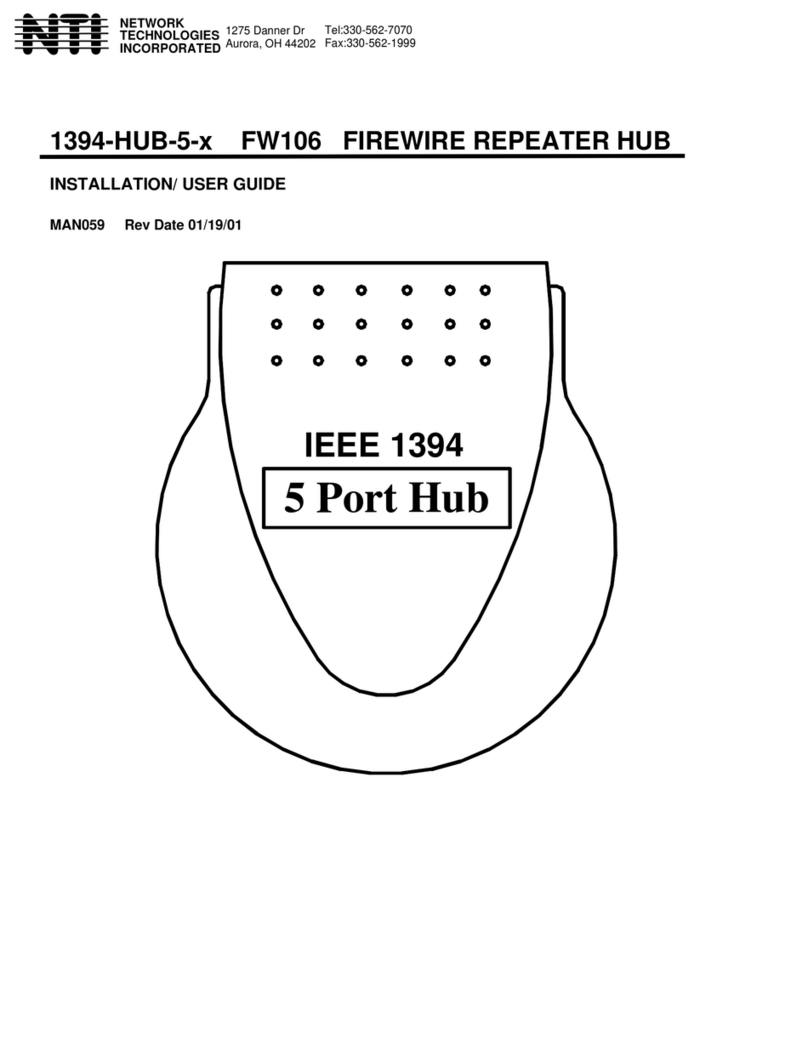
NTI
NTI 1394-HUB-5-x FW106 Operation manual
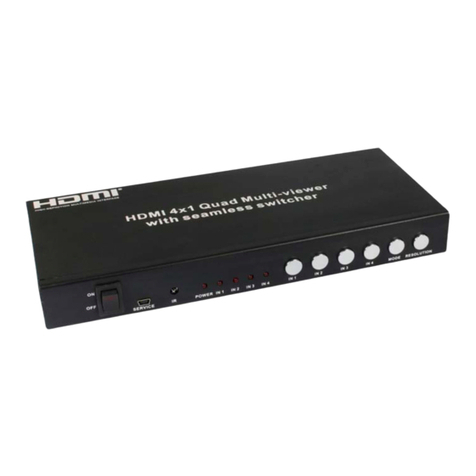
NTI
NTI Splitmux-C5HDR-4LC User manual
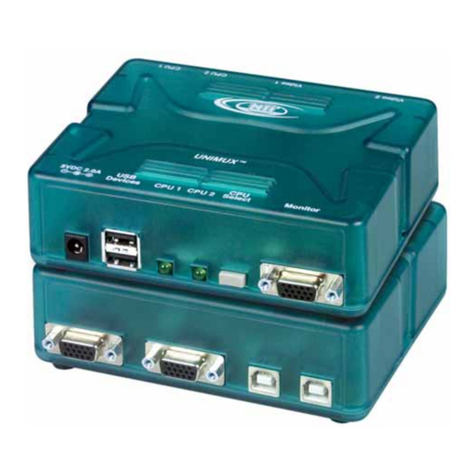
NTI
NTI KEEMUX-USBV-2U Operation manual
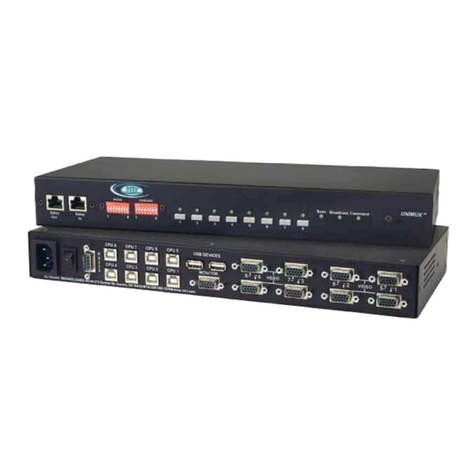
NTI
NTI USBV-x User manual
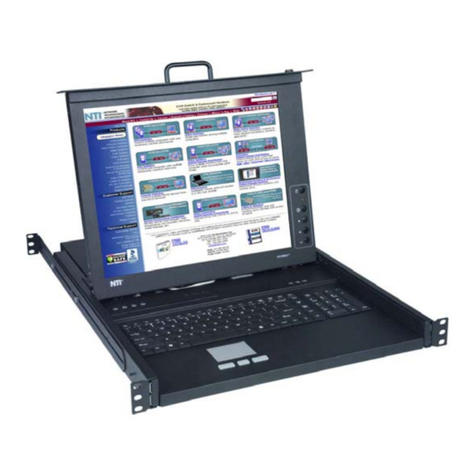
NTI
NTI RACKMUX-D17-N-16DVIHD User manual
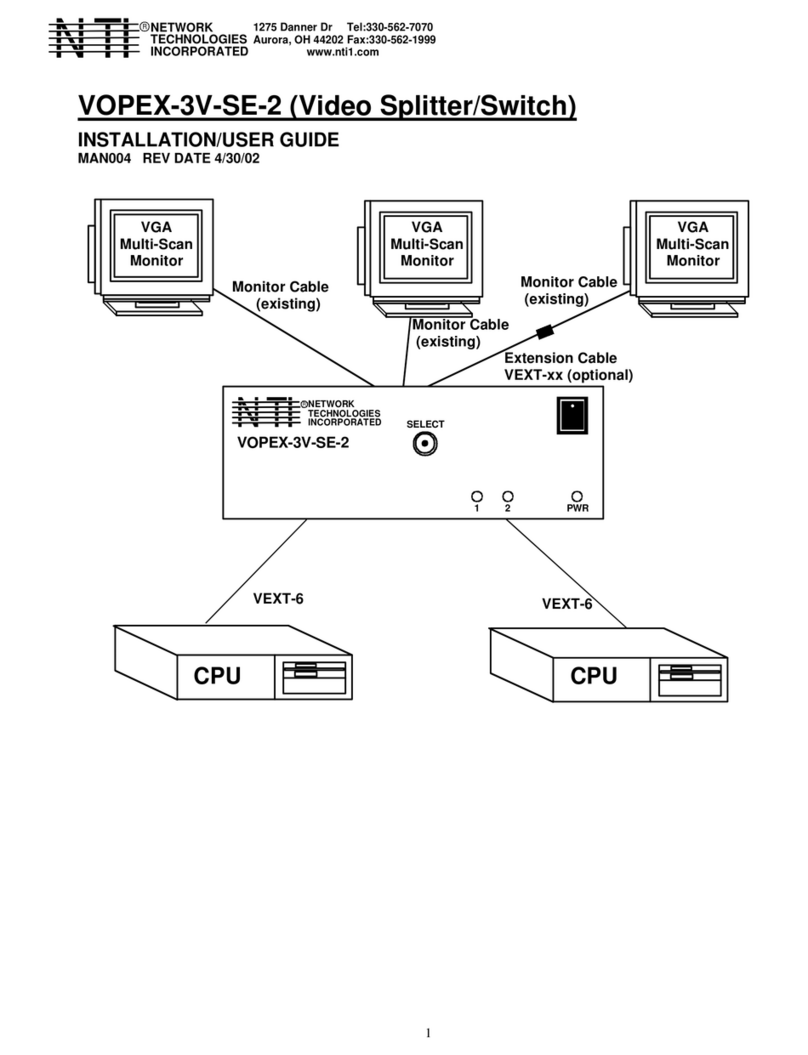
NTI
NTI VOPEX-3V-SE-2 Operation manual
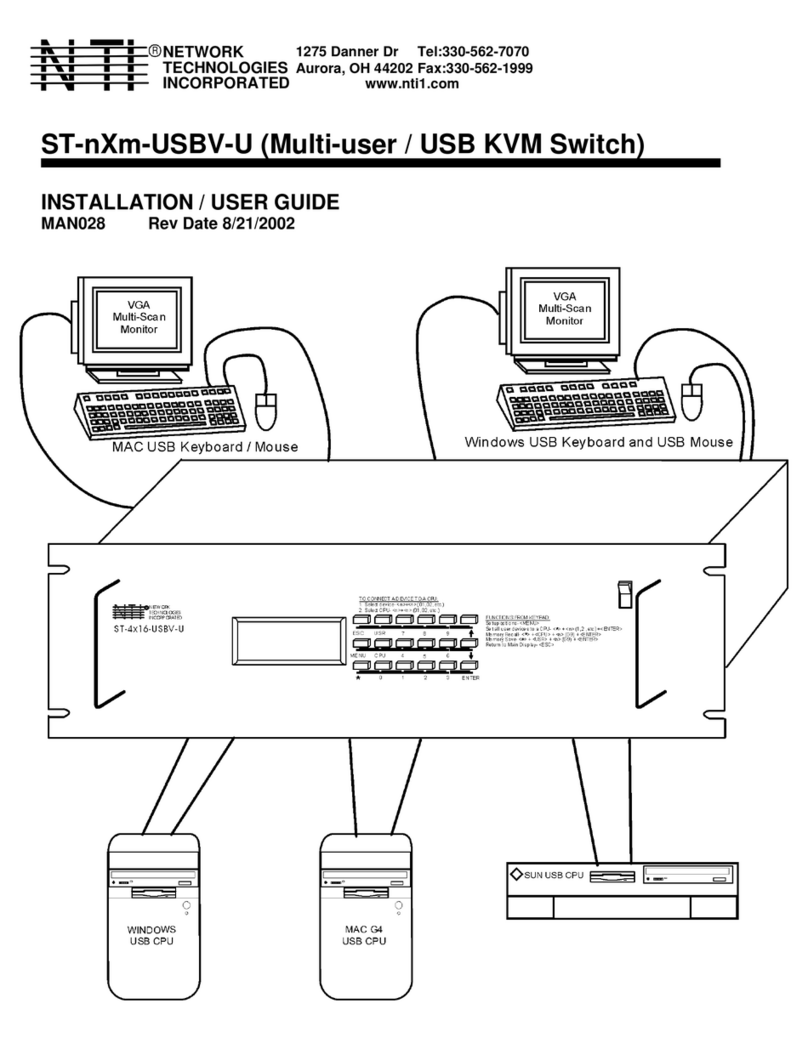
NTI
NTI ST-nXm-USBV-U Operation manual

NTI
NTI ST-nXm-U-HD User manual
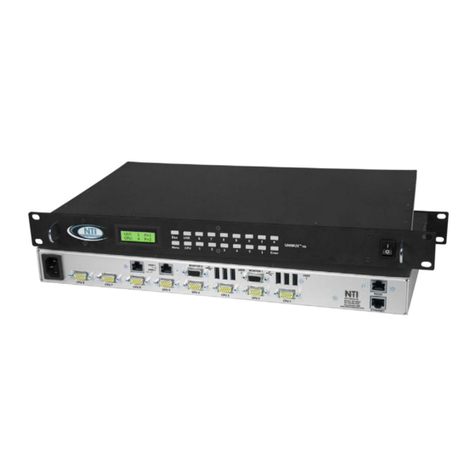
NTI
NTI UNIMUX-nXm-UHD User manual
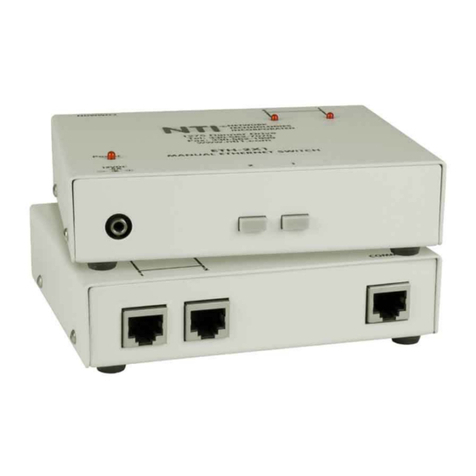
NTI
NTI ETH-4X1 User manual

NTI
NTI SM-16X16-HD4K Manual
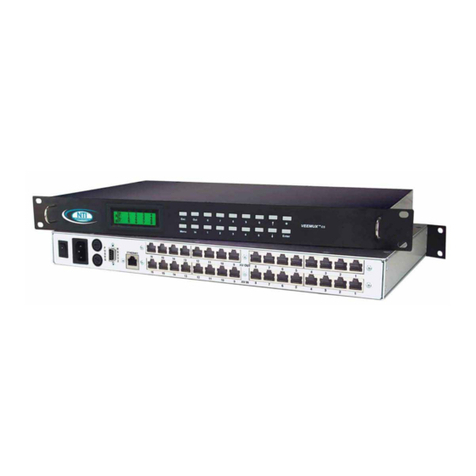
NTI
NTI VEEMUX SM-nXm-C5AV-LCD User manual

NTI
NTI UNIMUX-2X8-U User manual
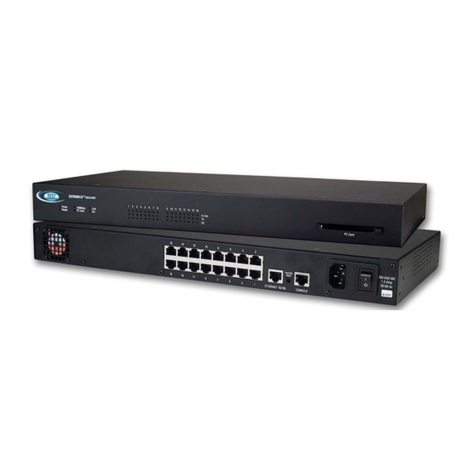
NTI
NTI SERIMUX-SECURE-x User manual
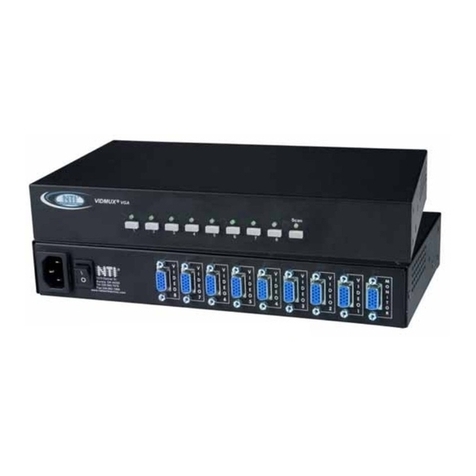
NTI
NTI SE-15V-xx-L User manual
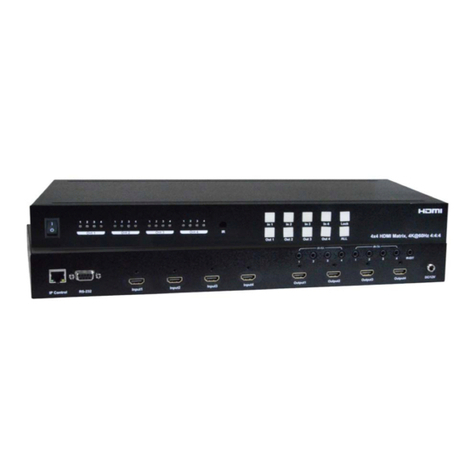
NTI
NTI SM-4X4-4K18GB-LC User manual

NTI
NTI ST-xU User manual
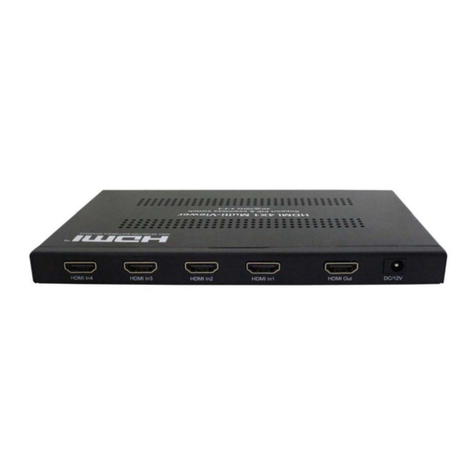
NTI
NTI SPLITMUX Series User manual
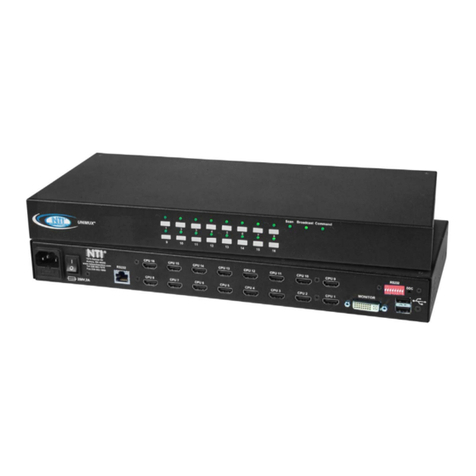
NTI
NTI unimux-dvi(a)-xhd User manual
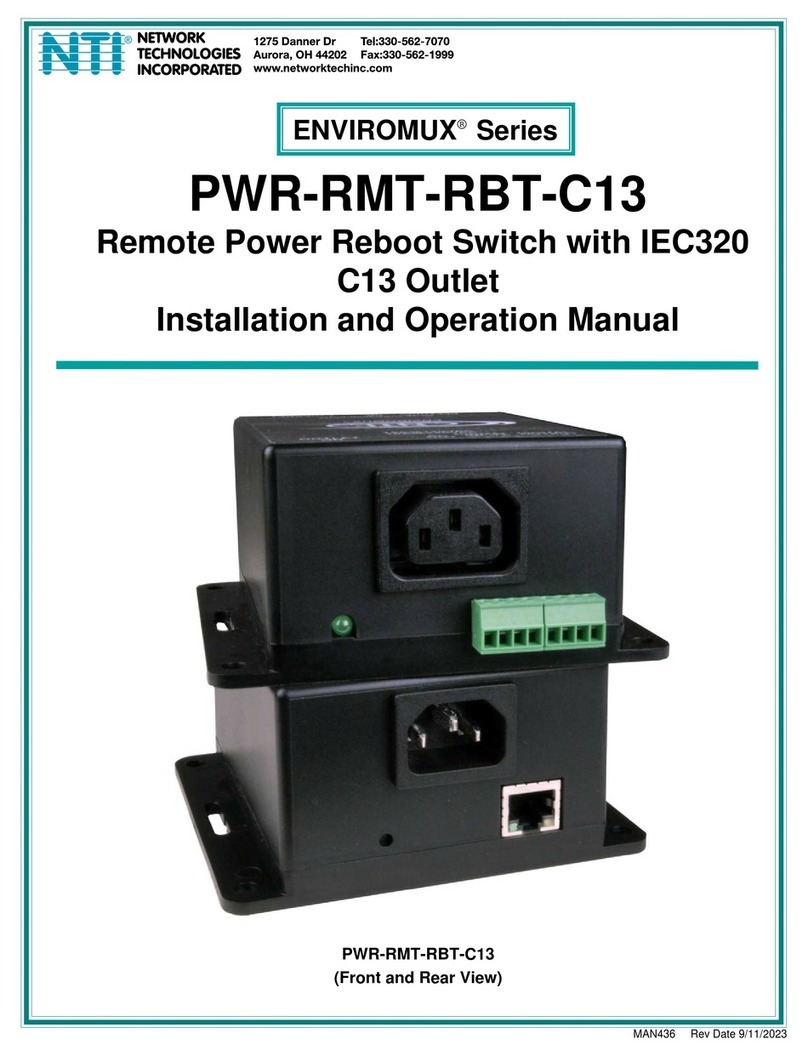
NTI
NTI ENVIROMUX Series User manual
